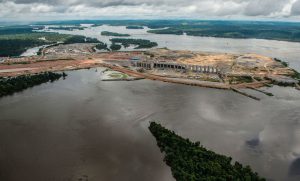Brazil is in the midst of a dam-building spree in the Amazon basin that is changing the face of the world’s largest tropical forest region. The boom is driven by the country’s agricultural and heavy industrial interests, is being carried out with little regard to the impacts on indigenous people and the environment, is proceeding with little effort to capitalise on the nation’s vast renewable energy potential, and is often fuelled by corruption.
The most notable example is the massive Belo Monte Dam, the world’s fourth-largest hydroelectric project. The dam itself has already blocked the 1,000-mile Xingu River, a major tributary of the Amazon. Belo Monte’s reservoir, filled at the end of 2015, flooded 260 square miles of lowlands and forest, displaced more than 20,000 people, and caused extensive damage to a river ecosystem that contains more than 500 fish species, many of them found nowhere else. When the turbine installation is complete, 80% of the river’s flow will be detoured from the river’s natural channel, which – among other impacts – will leave three indigenous groups without the fish and turtles on which they depend.
Now, the Brazilian government has set its sights on the Tapajós River, another major tributary of the Amazon River that drains an area larger than California and that stretches from the soy fields of Mato Grosso northward across the Amazon forest in the vast state of Pará before joining the Amazon at Santarém. Planned Tapajós Basin dams total 43 with at least 30 megawatts of installed capacity, plus many more with less. Of the 43, two have already had their reservoirs filled, two more are approaching this stage, and several of the largest ones are high on the list of future plans.
Should Brazil’s unfettered dam construction continue at the current pace, the country will essentially take all of the major free-flowing Amazon tributaries east of the Madeira River — in effect, half of the Amazon basin — and turn them into continuous chains of reservoirs. This would mean expelling all of the traditional residents from two-thirds of Brazilian Amazonia.
The construction of these hydroelectric projects is occurring at a time when Brazil is both weakening its environmental laws and regulations and ignoring those already on the books. In one key case — the São Luiz do Tapajós Dam — the environmental impact study was “archived” in 2016 by IBAMA, the Ministry of the Environment’s agency in charge of licensing. However, this highly controversial dam, which would flood indigenous land, remains in the plans of the Ministry of Mines and Energy and it could be “de-archived” at some future date.
The frequent turnover of ministers of the environment and heads of IBAMA, plus the history of political pressure forcing approval of dams over the objections of technical staff (as in the cases of the Madeira River Dams and Belo Monte), makes the eventual licensing of the São Luiz do Tapajós Dam likely in the future. In addition, proposals for laws and a constitutional amendment now rapidly advancing through the National Congress would effectively abolish environmental licensing altogether.
The planned Tapajós dams and the Belo Monte Dam share numerous parallels, including ulterior motives for giving the dams extraordinary priority. In the case of Belo Monte, this involves documented corruption, including affidavits submitted by some people participating in dam construction affirming that they made both legal and illegal “donations” to finance the 2010 and 2014 presidential campaigns of the victorious Workers’ Party in exchange for lucrative contracts. Belo Monte was 80% financed by Brazil’s government bank at 4% annual interest, while the government simultaneously financed itself by borrowing money at 10% annual interest. In the case of the Tapajós, a powerful ulterior motive is a planned waterway to transport soybeans for the country’s powerful agribusiness interests.
Both the Tapajós and Belo Monte projects featured extraordinarily damaging planned dams that would flood indigenous land, but plans for those dams vanished from official discourse despite multiple indications that the government intended to proceed with them. And both the Belo Monte and the Tapajos dams involve Chinese interests, with negotiations currently underway for the Chinese purchase of part of Belo Monte and with the already-consummated Chinese purchase of control of the São Manoel Dam, located adjacent to an indigenous area in the Tapajós Basin. Both Belo Monte and São Manoel had their operating licenses approved by the head of IBAMA, ignoring formal opinions by the agency’s technical staff, each with hundreds of pages of explanation of why the licenses should not be approved.
About 75% of Brazil’s electricity comes from hydropower, and the country is the second-largest producer of hydroelectricity in the world, behind China. The Brazilian government contends that the expansion of hydropower into the Amazon basin has made possible the country’s economic growth of recent decades and has helped bring power to regions that lacked electricity. The government also maintains that hydropower is a clean source of energy that helps fight climate change, and in the rain-rich Amazon, hydro dams provide a steady source of electricity not plagued by the intermittency problems of wind and solar energy.

Drowned trees in an area of Brazilian rainforest along the Araguari River that was flooded by dam construction. (Image: Daniel Beltrá/Greenpeace)
All of these arguments have been contested. Dams are not economically attractive if their true environmental and social costs are considered, the amount of electricity devoted to rural electrification is miniscule compared to other uses, hydropower is already unreliable and is projected to become much more so in light of climate change and projected shifts in rainfall patterns, and dams also emit significant quantities of methane, a greenhouse gas, from hydropower reservoirs.
Amazonian dams also have a panoply of social and environmental impacts that, if they were given proper weight in decision-making, would cause the Brazilian government to pursue instead the country’s abundant energy alternatives to obtain the benefits of electricity. Displacement of the human population that inhabits the areas chosen for flooding is one of the most immediately evident impacts. The plight of those displaced or left without livelihoods because of Belo Monte is a dramatic current example.
Future dams will mean far more evictions of both indigenous and non-indigenous groups. The Marabá Dam on the Tocantins River is expected to displace 40,000 people, most of whom are traditional riverside dwellers known as “ribeirinhos.” In the Tapajós basin, destruction of the Sete Quedas rapids by the Teles Pires dam in 2013 eliminated the most sacred location for the Mundurukú people — a site equivalent to heaven for Christians. The planned São Luiz do Tapajós Dam would destroy the site where the Mundurukú’s revered ancestor is said to have created the Tapajós River from four seeds of the tucumã palm. Mundurukú leaders voice concern over destruction of sacred sites even more than the loss of fish and other vital resources, but loss of these sites is not even considered an impact in the government’s environmental impact statements for the dams.
The environmental effects of Amazonian dams are sweeping. These include loss of substantial areas of forest, the most notorious so far being from the Balbina, Tucuruí and Samuel dams. The areas of forestlost to reservoir flooding were 1,200 square miles at Balbina, 744 square miles at Tucuruí, and 168 square miles at Samuel. At Balbina, virtually all of the forest was disturbed by non-indigenous occupants, while some of the forest at the other two dams has been exposed to logging. These losses are dwarfed by the Babaquara/Altamira hydropower project and other likely planned dams on the Xingu River upstream of Belo Monte. Babaquara/Altamira would flood more than 2,300 square miles of almost entirely undisturbed tropical forest.
Reservoir flooding is not the only way dams cause forest loss. These projects also provoke deforestation by the displaced population and by those attracted to the dam location, by occupation and invasion of forests along roads built to each dam site, and by activities stimulated by associated development, such as waterways for transporting soybeans. Dams are but one prong in a multifaceted deforestation process — involving logging, agriculture, ranching, and other development — that is destroying Brazil’s Amazon forest, especially from its eastern and southern edges.
Dams also block fish migrations, including iconic commercial species like the “giant catfish” of the Madeira River. They also hold back sediment and nutrient flows that sustain fish productivity throughout the Amazon. Reservoirs lack oxygen at their bottoms, causing mercury present in the soil to be transformed into the poisonous methyl form, which concentrates with each link in the food chain, on up to humans. People living around the Tucuruí reservoir have mercury levels in their hair more than four times higher than the wildcat gold miners (garimpeiros), who are notorious for their use of mercury. Fish in the reservoir have more than double the mercury level permitted for human consumption by World Health Organization standards.
And although proponents tout dams as a renewable source of energy, dams in Amazonia and elsewhere emit substantial amounts of greenhouse gases, especially methane, which has a much greater impact per tonne of gas than CO2 in the short term. The impact on global warming is being further augmented by carbon credits awarded to dams such as Teles Pires in the Tapajós basin and the Santo Antônio and Jirau on the Madeira River. All of these dams have been built for reasons that have nothing to do with combatting global warming. This means that the European countries that buy the carbon credits are allowed to emit millions of tonnes of carbon on the basis of dams that would be built anyway. Such projects drain “green” money that could otherwise be used for measures that really do serve to reduce global emissions, such as wind and solar energy projects.
Brazil has an enormous coastline with potential for offshore wind generation and has a vast semi-arid region with huge potential for solar power, in addition to largely untapped rooftop potential throughout the country. It also could use far less electricity by ceasing to export aluminum and other electro-intensive products, by reducing waste and transmission losses, and by increasing efficiency. Brazil’s official projections of energy demand are wildly exaggerated, being based on extrapolating exponential growth at 5% per year, although the most recent estimates have been forced to project lower growth rates in recognition of the country’s economic recession.
Contrary to industry and government assertions, hydro is not cheap power. The cost of Belo Monte has already risen to more than US$10 billion — well over double what was officially estimated when the decision to build the dam was made. And a survey of hundreds of large dams throughout the world shows that massive cost overruns and longer-than-expected construction times are the global norm, making many dams economically unviable without massive government subsidies.
Many dams are also planned in neighboring Amazonian countries, especially Peru and Bolivia, with major impacts on the environment and indigenous peoples. Many of the planned dams in the Amazonian portions of these countries are Brazilian dams, to be financed by Brazil’s National Bank for Economic and Social Development (BNDES). They will be built by Brazilian contractors and will serve primarily to export electricity to Brazil. Ironically, Brazil is shooting itself in the foot with these dams because the sediment flows they block will reduce fisheries all along Brazil’s portion of the Amazon River and in the “sweet sea” where the river enters the Atlantic Ocean.
Brazil’s current decision-making system is tilted towards options like dams, which maximise money flows to influential construction firms. Reforming the decision-making system to remove this underlying bias should be a top priority – not merely battling to halt each highly damaging dam that is proposed.
Brazil is surely one of the world’s most fortunate countries in having ample alternatives other than dams, fossil fuels, and nuclear power for meeting its electricity needs. However, options such as improving energy efficiency, foregoing electro-intensive exports, and tapping solar and wind resources are either entirely absent from government plans or receive only token consideration. Indeed, in January 2016, when considering large-scale electricity production in the current five-year development plan, Brazil’s president vetoed all non-hydropower alternatives.
This article was originally published by Yale Environment 360







